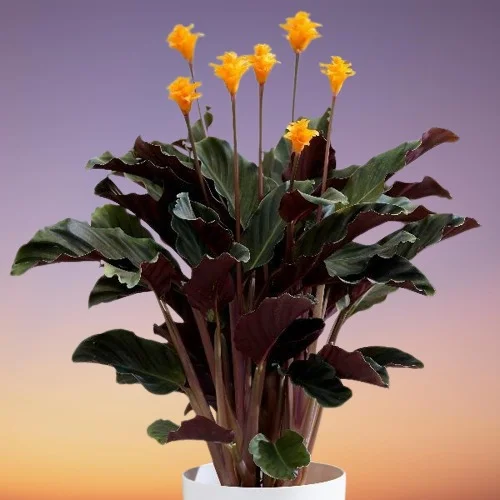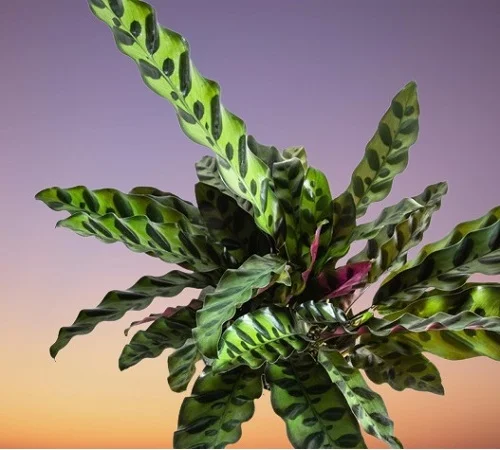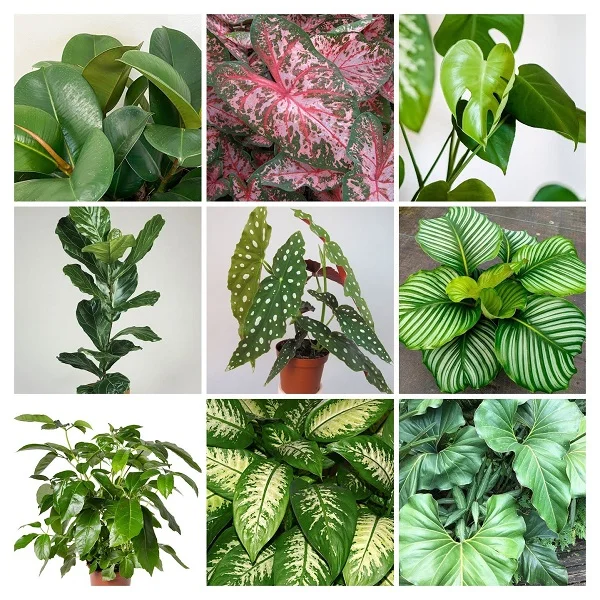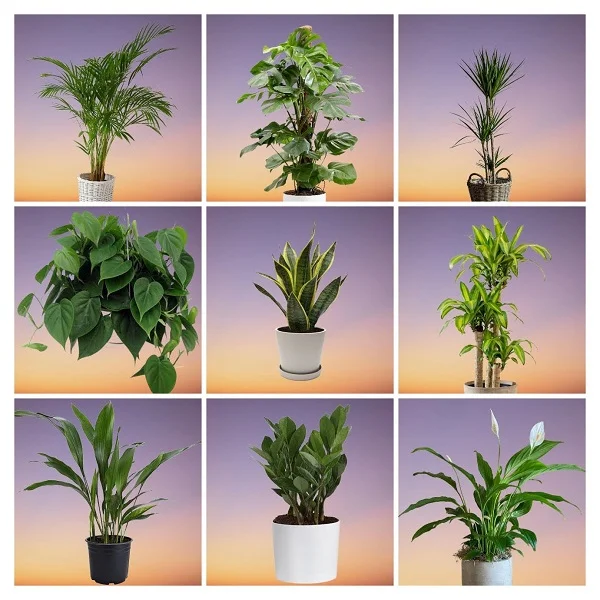Calathea Indoor Care Tips; Light, Water, Humidity, Temperature, Soil, Fertilizer, Repotting, Pruning
Some links in this post may be affiliate links
Calathea thrive in medium to bright indirect light, warm and humid conditions and moderately moist, rich, well-drained soils coupled with monthly feeding in the growing season.
Calatheas are popular plants grown for their ornately patterned leaves which will add a splash of color to any space and make a spectacular focal point in any room. They are liked for their curious characteristic of raising and closing their leaves at night.
The Calathea varieties are native to the tropical regions of America where they grow as understory plants. Like the shaded floors of their native tropical canopies, Calathea prefer medium to bright indirect light. Too much direct sunlight can damage their fragile leaves resulting in sunburn and dullness in the color of leaves.
Calathea flourish in moist but not soggy soil. Overwatering and soggy soil can cause rotting, yellowing and drooping. Underwatering can lead to brown leaf tips, yellowing and drooping leaves.
They require high humidity which mimics their natural habitat. Due to their need for high humidity, most of them are ideal for a closed terrarium or a bottle garden where a high humidity can be easily maintained.

There are about 60 species in the Calathea genus which belongs to the Marantaceae together with Marantas, Ctenanthe and Stromanthe which are collectively called Prayer Plants in reference to their curious characteristic of raising and closing their leaves at night.
According to ASPCA, Calathea are non-toxic to both humans and pets. They are considered to be safe for cats, dogs and other pets.
If you are looking to add Calathea Plants to your collection, you may obtain them online from Amazon (Link to Amazon).
How to care for Calathea indoors
To care for Calathea indoors, provide medium to bright indirect light (dappled light), warm and humid conditions and moderately moist, fertile, well-drained soils coupled with monthly feeding during the growing season.
Calathea are only repotted when they become pot-bound. Pruning is necessary to keep the plants neat and also discourage pest and disease infestation. They also need regular cleaning of the leaves to keep them clean and attractive. Keep reading for more on these growing conditions and how to provide them.

Watering
How often should I water a Calathea?
Water your Calathea liberally in spring and summer while allowing the top few inches of soil to dry out between waterings. Maintain the soil moist but not soggy to avoid rotting, yellowing and drooping.
Cut down on watering in fall and winter as growth is minimal at this time to keep the soil slightly moist. However, do not leave the soil to dry out completely to prevent yellowing, wilting and drooping leaves.
Use room temperature water to prevent cold shock which can result in stunted growth and death of the plant. Ascertain that the water is free of chlorine, flourides and other chemicals to prevent brown leaf tips and edges.
Ensure the pot has a drainage hole and the soil is well-draining to prevent waterlogging which can lead to root-rot and loss of the plant.
To prevent fungal infestations, avoid wetting the foliage during watering or water from the bottom instead.
Light Requirements
Where should I put Calathea in my house?
Calathea likes medium to bright indirect light as the beautiful leaf colors fade in too bright light. Put Calatheas near a bright window but away from direct sunlight as it can cause scorching on the leaves.
If the natural lighting is not sufficient, use full spectrum grow lights to supplement it to prevent yellowing and stunted growth.
Turn the pot regularly to ensure that the plant receives light on all sides for uniform growth and prevent lopsided growth.
Temperature & Humidity
Calathea prefer an average warmth of 15-260C; room temperatures that are comfortable for you are ideal for these plants.
Keep them away from drafts coming from AC units, heat vents, stoves, windy doors and windows among others to avoid sudden temperature changes which can cause reduced growth, curling and drooping leaves, and eventual death of the plant.
Calathea Plants require a humidity of 60-80%; low humidity will result in brown leaf tips and edges. To elevate humidity, set the pot on a wet pebble tray, use a humidifier or grow the plants in a well-lit bathroom and other moist areas. You may also grow the plants in a closed terrarium. Maintain good air circulation to minimize fungal diseases.
Fertilizer
What is the best fertilizer for Calathea?
Feed your Calathea with a balanced, liquid fertilizer once monthly in spring and summer to encourage a lush growth.
Do not feed in fall and winter as growth is minimal and feeding at this time can lead to fertilizer burn which is indicated by brown leaf tips and edges.
Flush out accumulated salts from the soil regularly by running a stream of water through the soil until it drips through the drainage hole. Allow the stream of water to run for some time and repeat the process several times.
Potting Soil
What kind of soil do Calathea like?
Calathea like a rich, loose, well-drained soil to prevent it from getting soggy while providing the required nutrients. A blend of 2 parts potting soil and 1 part perlite or vermiculite (for proper drainage) is ideal for these plants.
Repotting
Repot Calathea every 2 years at the beginning of the growing season (spring to early summer), only when pot-bound; they prosper when slightly root-bound.
Select a pot one size larger than the current one. Make sure that the pot has a drainage hole and the soil is free-draining to prevent waterlogging which can lead to root-rot and death of the plant. Take a look at these pots with drainage hole on Amazon.
One day before repotting, water the plant thoroughly to hasten establishment as a well hydrated plant suffers less repotting shock.
If the plant is too large and has outgrown its current pot, divide it into several sections and use the splits to propagate new plants.
Note that, repotting may cause the leaves to droop but the plant will eventually recover in about 3-4 weeks once it takes root.
Pruning & Grooming
Pruning Calathea involves removal of dead and yellow foliage to maintain the plant neat and also minimize pest and disease infestations.
Cut the leaves with a clean sharp knife or clean pruning scissors at the base, where the leaf meets the stalk. Make clean cuts to avoid unnecessary injuries and also reduce disease infestations.
Clean the leaves regularly by damp-wiping with a soft cloth to keep them clean and neat and also discourage pest infestation.
Calathea Propagation
Calathea are best propagated by plant division at the beginning of the growing season (spring to early summer) during repotting. Dividing the plant at this time hastens establishment as it is in the active growth phase. Unfortunately, Calathea will not propagate from leaf or stem cuttings.
Learn how to propagate Calathea Plants by 2 easy methods.

Calathea Problems & Solutions
Calathea common problems are drooping leaves, plant dying, curling leaves, yellow leaves, brown leaf tips, loss of leaf color, pests and diseases among others. Keep reading for more on these problems and how to fix them.
Drooping leaves
Some of the causes of drooping leaves on Calathea are dry air, incorrect watering, soggy soil, being pot-bound, pests infestations, temperature stress among others.
How to fix it
Dry air: To raise humidity, set the pot on a wet pebble tray, use a humidifier or grow the plant in a closed terrarium.
Incorrect watering: Do not water on a schedule. Water when the top few inches of soil feel dry but do not allow the soil to dry out completely.
Soggy soil: Make sure that the soil is free-draining and the pot has a drainage hole.
Being pot-bound: Repot the plant into a pot one size larger than the current one or divide it into several sections to propagate new plants.
Pests infestations: Regularly check betwwen and underneath the leaves for pests and carry out timely corrective measures.
Temperature stress: Keep the plant away from drafts emanating from hot air vents, stoves, AC units, wicy doors and windows among others.
Plant dying
Your Calathea is dying due to inconsistent watering, temperature stress, nutrients deficiency, low humidity, pests infestations or root-rot.
How to fix it
Inconsistent watering Water when the top few inches of soil dry out but do not allow the soil to dry out completely. Do not water on a schedule.
Temperature stress: Keep the plant away from drafts emanating from AC units, heat sources, windy doors, drafty windows, hot stoves among others.
Nutrients defeciency: Fertilize with a balanced, liquid fertilizer every 4 weeks in spring and summer.
Low humidity: To increase humidity, set the pot on a wet pebble tray or use a humidifier.
Pests infestations: Regularly inspect the plant for pests and carry out timely control measures.
Root-rot: The disease is prevalent in soggy soil.
- Carefully slip the plant out of its pot and inspect the roots.
- Trim the brown-black, mushy roots and treat the healthy roots with a copper-based fungicidal solution as indicated on the label.
- Disinfect the pot with the fungicidal solution or use a fresh pot to repot the plant in fresh, well-draining soil.
- Do not water the plant immediately and keep it dry for 5-7 days before you can resume watering.
- Use a pot with a drainage hole and well-draining soil to prevent the soil from getting soggy.
- Lessen watering in fall and winter as growth is slowed at this time; keep the soil slightly moist.
Curling leaves
Curling leaves on Calathea Plants are caused by inconsistent watering, soggy soil, drafts, dry air, being pot-bound.
How to fix it
Inconsistent watering: Water when the top few inches of soil feel dry but never allow the soil ball to dry out completely. Do not water on a schedule.
Soggy soil: Use a pot with a drainage hole and well-draining soil.
Drafts: Keep the plant away from drafts coming from AC units, heat sources, windy doors, drafty windows, hot air vents among others.
Dry air: To upscale humidity, set the pot on a wet pebble tray or use a humidifier.
Being pot-bound: Repot the plant into a pot one size larger when you spot roots growing through the drainage hole or divide it into several sections to propagate new plants.
Yellow leaves
The main causes of yellow leaves on Calathea are inconsistent watering, soggy soil, extreme temperatures, lack of nutrients or too little light.
How to fix it
Inconsistent watering: Water when the top few inches of soil dry out but never allow the soil ball to dry out completely.
Soggy soil: Use a pot with a drainage hole and well-draining soil. In addition, empty the saucer after watering.
Extreme temperatures: Keep the plant away from sources of drafts like AC units, heat sources, windy doors, drafty windows, hot air vents among others.
Lack of nutrients: Fertilize the plant with a balanced, liquid fertilizer every 4 weeks in spring and summer.
Too little light: Place the plant where it will receive bright indirect light or use a grow light if the natural lighting is too low.
Brown leaf tips and edges
Brown leaf tips and edges on Calatheas are due to dry air, pests infestations, use of hard water or salts buildup.
How to fix it
Dry air: To raise humidity, set the pot on a wet pebble tray or grow the plant in a well-lit bathroom, laundry area and other moist areas in the home.
Pests infestation: Remove the dead growth and raise humidity for the plant to discourage the pest infestations.
Use of hard water: Water the plant with rain water or filtered water.
Salts buildup: Regularly, flush out accumulated salts by running a stream of water through the soil until it drains through the drainage hole.
Loss of leaf color
Loss of leaf color on Calathea is caused by exposure of the plant to direct sunlight. Position the plant in a more shaded spot or instal a sheer curtain to filter the sunlight.
Pests
Common pests on Calathea are mealybugs, aphids, scale insects and spidermites.
How to fix it
- Isolate the affected plant to prevent spread to the rest of the plants.
- Treat the infested plant with neem oil or insecticidal soap as per the manufacturers' recommendations.
- Regularly check underneath and between the leaves for these pests and carry out timely control measures.
- Maintain the plant well pruned and raise humidity to discourage pest infestation.
Diseases
Calathea are prone to leaf spot disease which is prevalent in stuffy, humid conditions. The disease is characterized by brown patches surrounded by a yellow halo (soft leaf spots).
How to fix it
- Remove and burn the affected parts to reduce the risk of spread to the rest of the plants.
- Spray the affected plant with a systemic fungicide and ensure to follow the manufacturers instructions.
- Maintain the plant on the dry side for some time and ensure good air flow.
- Use a pot with a drainage hole and well-draining soil.
You liked it? Share on social media.
Related Content
Amazon Associates Disclosure
Homeplantsguide.com is a participant in the Amazon Services LLC Associates Program, an affiliate advertising program designed to provide a means for sites to earn advertising fees by advertising and linking to amazon.com.





